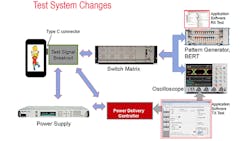It’s such a good idea that it’s amazing no one thought of it before: Make a 10-Gbit/s interface that can deliver up to 100 W—bidirectional—with an orientation-independent connector so you’re not fumbling to get it in, or searching for a cable because you brought the wrong one. Now they’re all the same. Or will be. Someday.
The USB Implementers Forum (IF) brought us all this with the new USB 3.1 standard and the introduction of the USB Type C connector. It also included an interesting, but not much discussed Alternate Mode. This allows devices to dynamically reassign USB Type C pin functionality by communication via the power delivery channel. So, in theory, a device could wake up as USB 3.1, and then switch to DisplayPort 1.3.
The connector’s basic form factor has already been adopted by Apple and Google, but don’t expect 10-Gbits/s communications or 100 W any time soon. The Apple MacBook tops out at 5 Gbits/s and 20 W.
It turns out that the new standard is kind of testy, if not downright ornery. It’s so “out there” that the USB IF still hasn’t even been able to come up with a compliance regimen, though there are tons of interesting USB 3.1 design-related material to sift through on the website in the meantime, to get you started.
To cut to the chase on these testy test issues, I needed help, so I had a chat with Joel Woodward, high-speed digital technologist at Keysight.
It turns out Woodward’s pretty excited about USB 3.1 and Type C. Not only is it an interesting test challenge, but he sees it as an enormous discontinuity in the market as companies gather around to support it. “There’s some hope in the industry that this will be the one connector to rule them all, like some kind of ‘Lord of the Rings’ [-type connector].”
Between now and then, however, a large number of test challenges introduced by the standard and the connector need to be overcome (Fig. 1). Woodward quickly jumped to the issues that the seemingly simple concept of orientation independence brings up.
Off the bat, this doubles the number of ports to be tested and validated. When cable is turned around and plugged back in, it’s actually matching its own transmitter/receiver (Tx/Rx) pair to a completely different Tx/Rx pair on the device.
Now designers need to think about testing one way, then turning the connector and testing the other way, and running all the same tests, and those tests can take hours per iteration.
“People haven’t thought about that yet,” said Woodward. “They’ve thought about, ‘Man, we’re making this great new tester. We can plug it in both ways. We’ve got all of this other capability,’ but they haven’t thought about the implication in terms of test time and test complexity.”
The same issues apply for power, in that again there are no compliance tests and so there are a lot of unknowns about this, too.
Woodward pointed to other issues, including:
- Alternate modes: Being capable of carrying USB and DisplayPort signals sounds good, but it also increases the number of compliance regimens to run; DisplayPort 3.1 has its own testing requirements.
- Power Management: The device can sink and/or source current. Not specifically addressed in the Compliance Test considerations, but it is entirely possible that all “notable” modes of operation will have to be active for compliance testing. What kind of loading/charging conditions are required? Regardless of the compliance requirement, validation engineers will test in a great many conditions
- VCONN Power Management: A device can operate certain devices over VCONN. Would this be another operational mode? Testing under load conditions for VCONN: a number of established load conditions or just worst-case?
As to what Keysight itself is doing about USB 3.1 and Type C, Woodward said it’s got a division for cable characteristics testing, a division focused on oscilloscopes for USB 3.1 test, a signal-source division in Germany that can inject signals, stress that signal, and test how good a receiver does. Also Its EEsof in California has a number of new modeling technologies for the USB 3.1 and for the type C connectors as well.
“We also worry about fixturing, how we connect things,” said Woodward, “so we’re looking at building little adapters for testing that mate up to the type C connector, so that we can do all those various tests as well.”
Maybe, somewhere in a galaxy far, far away, someone did dream of an interface like USB 3.1 with Type-C. And maybe they have it already. But here on Earth in the present, the dream is just beginning to unfold and test vendors like Keysight, with smart folks like Joel Woodward are our Jedi Warriors making it happen.
About the Author
Patrick Mannion Blog
Founder and Managing Director
Patrick Mannion is Founder and Managing Director of ClariTek, LLC, a high-tech editorial services company. After graduating with a National Diploma in Electronic Engineering from the Dundalk Institute of Technology, he worked for three years in the industry before starting a career in b2b media and events. He has been covering the engineering, technology, design, and the electronics industry for 25 years. His various roles included Components and Communications Editor at Electronic Design and more recently Brand Director for UBM's Electronics media, including EDN, EETimes, Embedded.com, and TechOnline.

